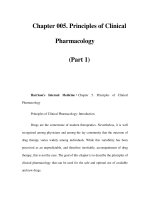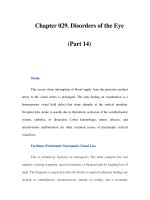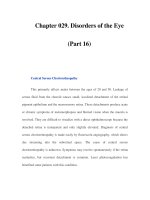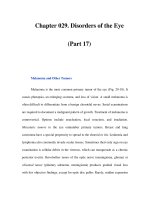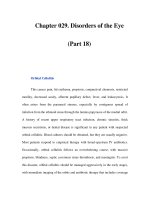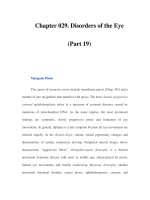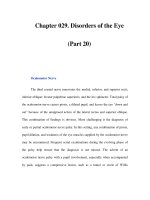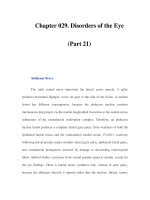Chapter 083. Cancer of the Skin (Part 1) ppt
Bạn đang xem bản rút gọn của tài liệu. Xem và tải ngay bản đầy đủ của tài liệu tại đây (79.57 KB, 6 trang )
Chapter 083. Cancer of the Skin
(Part 1)
Harrison's Internal Medicine > Chapter 83. Cancer of the Skin
Melanoma
Pigmented lesions are among the most common findings on skin
examination. The challenge is to distinguish cutaneous melanomas, which may be
lethal, from the remainder, which with rare exceptions are benign. Examples of
malignant and benign pigmented lesions are shown in Fig. 83-1.
Figure 83-1
Atypical and malignant pigmented lesions.
The most common melanoma
is superficial spreading melanoma (not pictured). A.
Acral lentiginous melanoma
is the most common melanoma in blacks, Asians, and Hispanics and occurs as an
enlarging hyperpigmented macule or plaqu
e on the palms and soles. Lateral
pigment diffusion is present. B.
Nodular melanoma most commonly manifests
itself as a rapidly growing, often ulcerated or crusted black nodule. C.
Lentigo
maligna melanoma occurs on sun-exposed skin as a large, hyperpigmen
ted macule
or plaque with irregular borders and variable pigmentation. D.
Dysplastic nevi are
irregularly pigmented and shaped nevomelanocytic lesions which may be
associated with familial melanoma.
Epidemiology
Melanomas originate from neural crest-derived melanocytes; pigment cells
present normally in the epidermis and sometimes in the dermis. This tumor affects
around 62,000 individuals per year in the United States, resulting in 7910 deaths.
Melanoma is the fifth most common cancer in men (5% of cancers) and the sixth
most common in women (4% of cancers). The tumor can affect adults of all ages,
even young individuals (starting in the mid-teens); has distinct clinical features
that make it detectable at a time when cure by surgical excision is possible; and is
located on the skin surface, where it is visible. The incidence has increased
dramatically (6% per year from 1973 to 1980, then 3% per year). Current lifetime
risk ratio is 1:53 in males and 1:78 in females. The reason for this increase is
uncertain but may involve increased recreational sun exposure, especially early in
life. Individuals of similar ethnic background who immigrate after childhood to
areas of high sun exposure (e.g., Israel and Australia) have lower melanoma rates
than individuals of similar age who were either born in those countries or
immigrated before age 10. The individuals most susceptible to development of
melanoma are those with fair complexions, red or blond hair, blue eyes, and
freckles and who tan poorly and sunburn easily. Other factors associated with
increased risk include a family history of melanoma (~1 in 10 melanoma patients
have a family member with melanoma), the presence of a clinically atypical mole
(dysplastic nevus) or a giant congenital melanocytic nevus, the presence of a
higher than average number of ordinary melanocytic nevi, and
immunosuppression (Table 83-1). Individuals with 50 or more moles ≥2 mm in
size have a 64-fold increased risk. About 30% of melanomas arise in a nevus.
Some individuals with multiple primary melanomas and/or a strong family history
have heritable mutations in the CDKN2A gene. Melanoma is relatively rare in
heavily pigmented peoples. Dark-skinned populations (such as those of India and
Puerto Rico), blacks, and East Asians have rates 10–20 times lower than lighter-
skinned whites. In keeping with the role of sun exposure, the incidence is
inversely correlated with the latitude of residence; at any latitude, darker-skinned
persons have the lowest incidence. Melanoma is rare in children under age 10.
Table 83-1 Risk Factors for Cutaneous Melanoma
High risk (>50-fold increase in risk)
Persistently changing mole
Clinically atypical moles in patient with two family members with
melanoma
Adulthood (vs. childhood)
>50 nevi ≥2 mm in diameter
Intermediate risk (~10-fold increase in risk)
Family history of melanoma
Sporadic clinically atypical moles
Congenital nevi (?)
White ethnicity (vs. black or East Asian ethnicity)
Personal history of prior melanoma
Low risk (2- to 4-fold increase in risk)
Immunosuppression
Sun sensitivity or excess exposure to sun
Source: Adapted from AR Rhodes et al: JAMA 258:3146, 1987.
